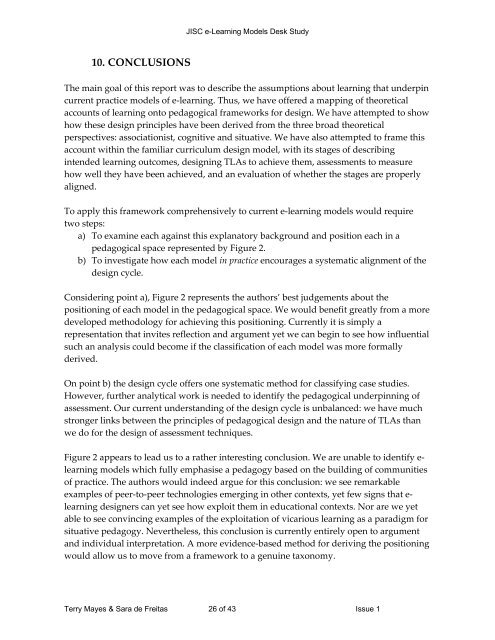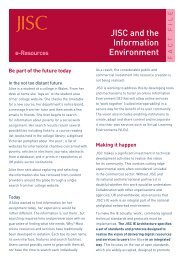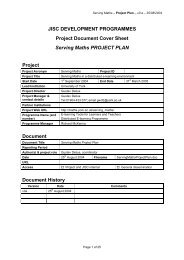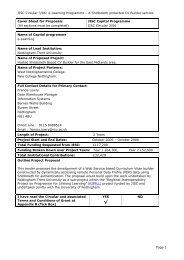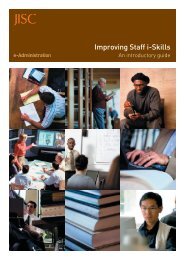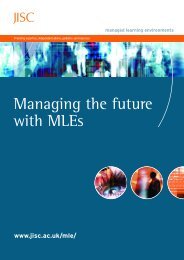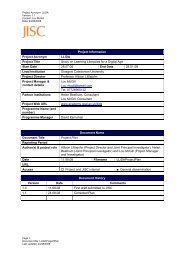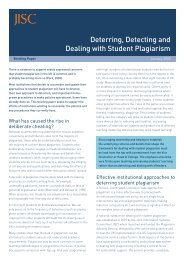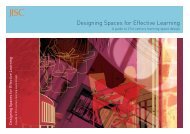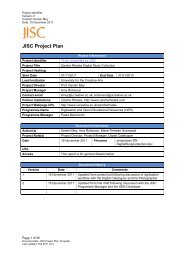Review of e-learning theories, frameworks and models - Jisc
Review of e-learning theories, frameworks and models - Jisc
Review of e-learning theories, frameworks and models - Jisc
You also want an ePaper? Increase the reach of your titles
YUMPU automatically turns print PDFs into web optimized ePapers that Google loves.
10. CONCLUSIONS<br />
JISC e-Learning Models Desk Study<br />
The main goal <strong>of</strong> this report was to describe the assumptions about <strong>learning</strong> that underpin<br />
current practice <strong>models</strong> <strong>of</strong> e-<strong>learning</strong>. Thus, we have <strong>of</strong>fered a mapping <strong>of</strong> theoretical<br />
accounts <strong>of</strong> <strong>learning</strong> onto pedagogical <strong>frameworks</strong> for design. We have attempted to show<br />
how these design principles have been derived from the three broad theoretical<br />
perspectives: associationist, cognitive <strong>and</strong> situative. We have also attempted to frame this<br />
account within the familiar curriculum design model, with its stages <strong>of</strong> describing<br />
intended <strong>learning</strong> outcomes, designing TLAs to achieve them, assessments to measure<br />
how well they have been achieved, <strong>and</strong> an evaluation <strong>of</strong> whether the stages are properly<br />
aligned.<br />
To apply this framework comprehensively to current e-<strong>learning</strong> <strong>models</strong> would require<br />
two steps:<br />
a) To examine each against this explanatory background <strong>and</strong> position each in a<br />
pedagogical space represented by Figure 2.<br />
b) To investigate how each model in practice encourages a systematic alignment <strong>of</strong> the<br />
design cycle.<br />
Considering point a), Figure 2 represents the authors’ best judgements about the<br />
positioning <strong>of</strong> each model in the pedagogical space. We would benefit greatly from a more<br />
developed methodology for achieving this positioning. Currently it is simply a<br />
representation that invites reflection <strong>and</strong> argument yet we can begin to see how influential<br />
such an analysis could become if the classification <strong>of</strong> each model was more formally<br />
derived.<br />
On point b) the design cycle <strong>of</strong>fers one systematic method for classifying case studies.<br />
However, further analytical work is needed to identify the pedagogical underpinning <strong>of</strong><br />
assessment. Our current underst<strong>and</strong>ing <strong>of</strong> the design cycle is unbalanced: we have much<br />
stronger links between the principles <strong>of</strong> pedagogical design <strong>and</strong> the nature <strong>of</strong> TLAs than<br />
we do for the design <strong>of</strong> assessment techniques.<br />
Figure 2 appears to lead us to a rather interesting conclusion. We are unable to identify e<strong>learning</strong><br />
<strong>models</strong> which fully emphasise a pedagogy based on the building <strong>of</strong> communities<br />
<strong>of</strong> practice. The authors would indeed argue for this conclusion: we see remarkable<br />
examples <strong>of</strong> peer-to-peer technologies emerging in other contexts, yet few signs that e<strong>learning</strong><br />
designers can yet see how exploit them in educational contexts. Nor are we yet<br />
able to see convincing examples <strong>of</strong> the exploitation <strong>of</strong> vicarious <strong>learning</strong> as a paradigm for<br />
situative pedagogy. Nevertheless, this conclusion is currently entirely open to argument<br />
<strong>and</strong> individual interpretation. A more evidence-based method for deriving the positioning<br />
would allow us to move from a framework to a genuine taxonomy.<br />
Terry Mayes & Sara de Freitas 26 <strong>of</strong> 43 Issue 1


